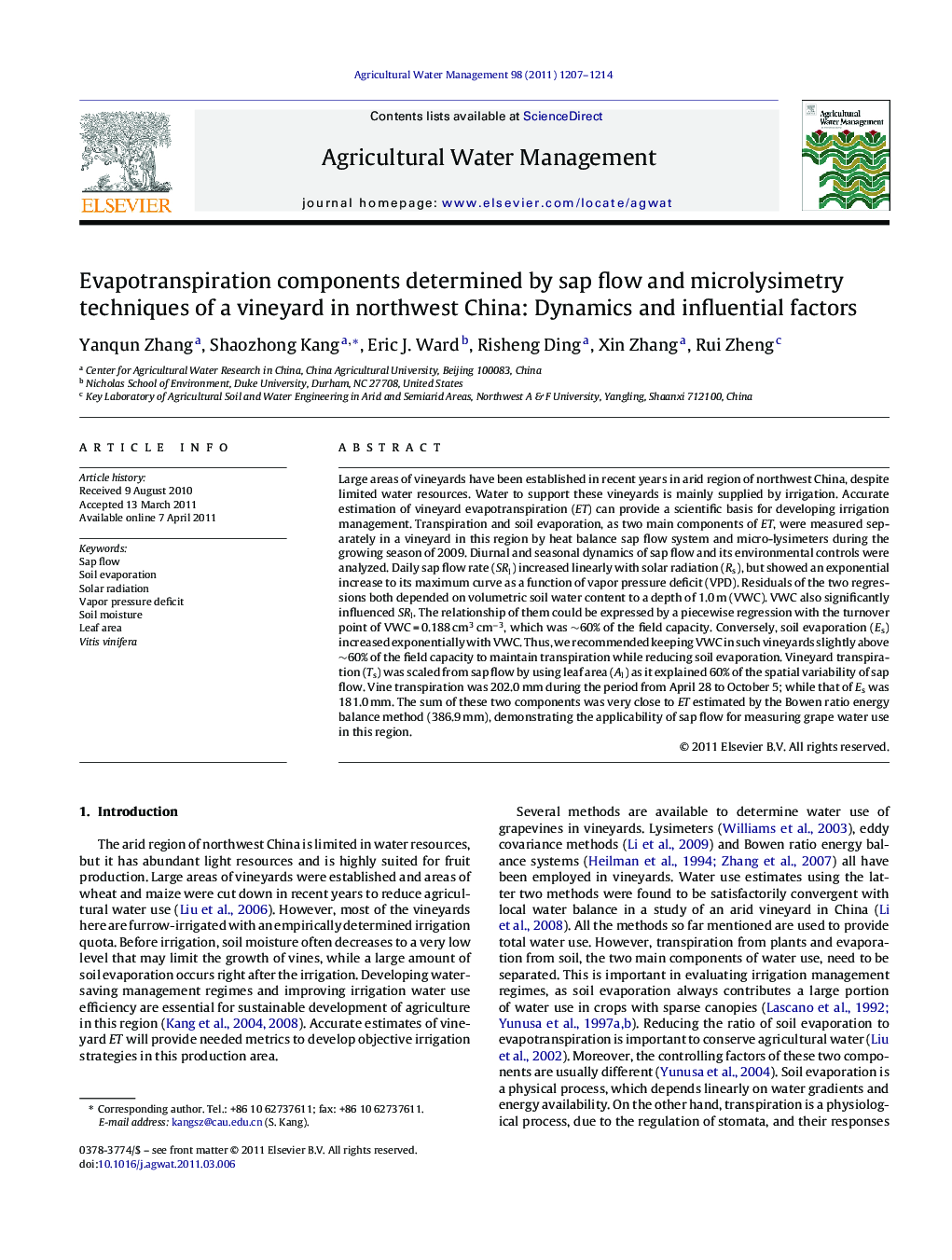| کد مقاله | کد نشریه | سال انتشار | مقاله انگلیسی | نسخه تمام متن |
|---|---|---|---|---|
| 4479480 | 1316445 | 2011 | 8 صفحه PDF | دانلود رایگان |

Large areas of vineyards have been established in recent years in arid region of northwest China, despite limited water resources. Water to support these vineyards is mainly supplied by irrigation. Accurate estimation of vineyard evapotranspiration (ET) can provide a scientific basis for developing irrigation management. Transpiration and soil evaporation, as two main components of ET, were measured separately in a vineyard in this region by heat balance sap flow system and micro-lysimeters during the growing season of 2009. Diurnal and seasonal dynamics of sap flow and its environmental controls were analyzed. Daily sap flow rate (SRl) increased linearly with solar radiation (Rs), but showed an exponential increase to its maximum curve as a function of vapor pressure deficit (VPD). Residuals of the two regressions both depended on volumetric soil water content to a depth of 1.0 m (VWC). VWC also significantly influenced SRl. The relationship of them could be expressed by a piecewise regression with the turnover point of VWC = 0.188 cm3 cm−3, which was ∼60% of the field capacity. Conversely, soil evaporation (Es) increased exponentially with VWC. Thus, we recommended keeping VWC in such vineyards slightly above ∼60% of the field capacity to maintain transpiration while reducing soil evaporation. Vineyard transpiration (Ts) was scaled from sap flow by using leaf area (Al) as it explained 60% of the spatial variability of sap flow. Vine transpiration was 202.0 mm during the period from April 28 to October 5; while that of Es was 181.0 mm. The sum of these two components was very close to ET estimated by the Bowen ratio energy balance method (386.9 mm), demonstrating the applicability of sap flow for measuring grape water use in this region.
► Sap flow and evaporation were measured separately by heat balance sap flow system and micro-lysimeters in our vineyard. Diurnal and seasonal dynamics of sap flow and its environmental controls were analyzed.
► Sap flow rate fluctuated diurnally and seasonally along with solar radiation and vapor pressure deficit. Volumetric soil water content to a depth of 1.0 m (VWC) influenced sap flow rate only when it fell below 0.188 cm3 cm−3. However, soil evaporation increased exponentially with VWC.
► When scaling vineyard transpiration from sap flow, leaf area, rather than stem diameter or vine cross-sectional area, should be selected as an indicator of individual sap flow variability.
► The sum of transpiration and evaporation was satisfactorily consistent to evapotranspiration measured by the Bowen ratio energy balance system, demonstrating the applicability of sap flow for measuring grape water use in this region.
► Soil evaporation accounted for 47.3% of total evapotranspiration. Keeping the VWC in such vineyards slightly above ∼60% of the field capacity could reduce the ratio of soil evaporation to evapotranspiration, according to the different response to VWC for sap flow rate and soil evaporation.
Journal: Agricultural Water Management - Volume 98, Issue 8, 30 May 2011, Pages 1207–1214